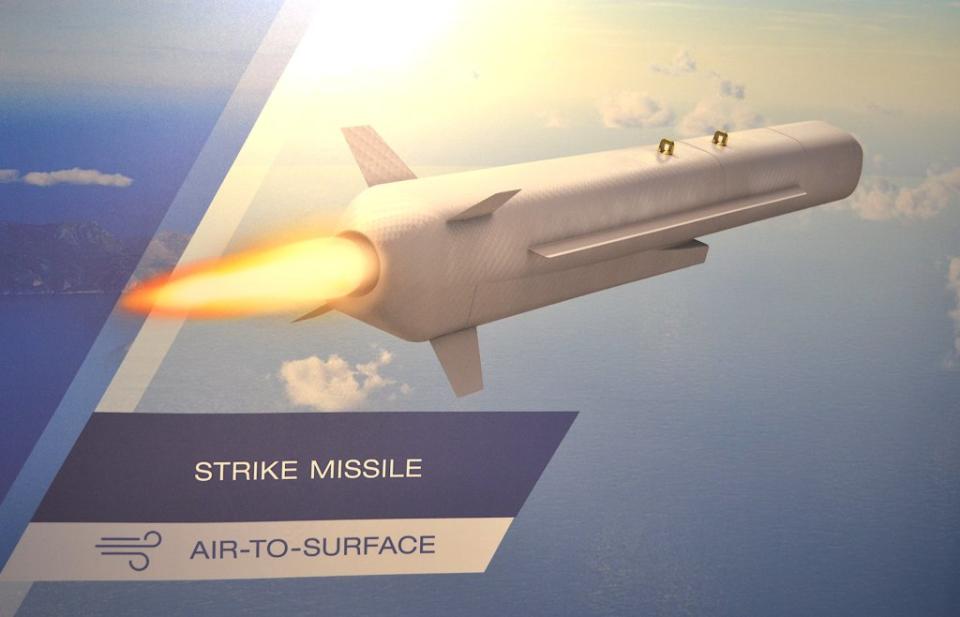General Atomics has offered a look at a new air-to-surface missile it is developing. The emergence of the project comes at a time of great and still growing interest, especially within the U.S. military, in new air-launched strike munitions, particularly ones that are cheaper and easier to produce than existing designs.
A rendering of the new weapon from General Atomics’ Electromagnetic Systems Group, currently referred to simply as the “Strike Missile,” is on display at the company’s booth at the Surface Navy Association’s main annual symposium that kicked off this week. A company representative on the show floor could not provide TWZ with any additional information and cautioned that the name could change in the future.
From what can be seen in the rendering, the slab-sided design with two lugs on top features an air-breathing propulsion system with a single ventral intake. A long rectangular strake is also visible along the body and there are four additional fins at the tail end. There are no other clear indications as yet about its size, performance, and other specifications.
A picture of the Strike Missile rendering on display at General Atomics’ booth at the 2025 Surface Navy Association main annual symposium. Joseph Trevithick
TWZ is not aware of any past forays on General Atomics’ part into the realm of traditional air-to-surface missile development. The company’s website does mention past experience with developing surface-to-surface and surface-to-air munitions, including lower-cost and modular designs. Its Aeronautical Systems division also has extensive experience with air-launched drones.
A rendering of the General Atomics Rapid Affordable Modular Missile (RAMM), a surface-to-air missile design. General Atomics
A model of General Atomics’ Eaglet, one of a number of air-launched drones the company has been developing in recent years. Howard Altman
In general, as TWZ has noted in the past, the line between uncrewed aerial systems, especially longer-range kamikaze drones, and cruise missiles, as well as decoys carrying electronic warfare payloads, is increasingly blurry. A single modular design could be configured to perform different mission sets, as well.
General Atomics’ own Advanced Air Launched Effects (A2LE) uncrewed aerial system is a good example of the increasingly blurry line between drones, cruise missiles, and decoys. General Atomics
Advertisement
Advertisement
As already mentioned, the U.S. military is very interested in acquiring new air-launched strike munitions, especially lower-cost types that can be produced readily at scale, but that also still offer appreciable range. Pursuing these kinds of weapons is increasingly seen as vital for providing sufficient strike capacity in future conflicts, especially high-end ones like a fight in the Pacific against China, and allowing for the relatively rapid replenishment of stockpiles.
The U.S. Navy’s Multi-Mission Affordable Capacity Effector (MACE) and U.S. Air Force’s Extended Range Attack Munition (ERAM) are prime examples of new projects that have emerged just in the past year to help address these needs, following on from years of other similar efforts. The Air Force and the Pentagon’s Defense Innovation Unit (DIU) are working on another project called the Enterprise Test Vehicle (ETV), which could be a stepping stone to new lower-cost cruise missiles. General Atomics is not one of the four companies – Anduril Industries, Integrated Solutions for Systems, Inc., Leidos subsidiary Dynetics, and Zone 5 Technologies – known to have received ETV contracts.
The Anduril barracuda-500M, one of the designs now being developed under the Enterprise Test Vehicle program. Anduril
It also emerged last year that ERAM is primarily focused on delivering a new air-launched munition capability to Ukraine. The Pentagon has since disclosed that Denmark and the Netherlands are involved in that particular effort, as well. This underscores the additional interest in these kinds of lower-cost air-launched strike munitions that exists outside of the United States.
Altogether it is unsurprising that General Atomics would be looking to enter this growing market space. In addition, having a weapon like this within the company’s portfolios means it could also be pitched directly in combination with its uncrewed aircraft offerings to new and existing operators. This could be especially pertinent when it comes to existing designs like the MQ-9 Reaper that have shown to be increasingly vulnerable even to opponents with relatively limited air defense capabilities. General Atomics has previously presented a vision of the Reaper as a potential stand-off munitions ‘truck,’ which could be one way to try to help ensure their relevance in future conflicts. The Strike Missile might be able to fit inside internal bays, as well as under the wings, of other drone designs, including the one General Atomics is developing as part of the Air Force’s Collaborative Combat Aircraft (CCA) program.
A rendering of an MQ-9-series drone in Royal Australian Air Force (RAAF) colors armed with four Joint Strike Missile (JSM) cruise missiles. Raytheon in the United States jointly developed the JSM with Norway’s Kongsberg. General Atomics A rendering depicting an MQ-9 Reaper in Royal Australian Air Force markings carrying four Joint Strike Missile (JSM) cruise missiles, as well as other stores. General Atomics
While little is known about General Atomics’ new Strike Missile, we hope to learn more. Regardless, it is the latest example of a still-growing trend in the emergence of new air-launched munitions within the U.S. defense sector.
Contact the author: joe@twz.com
EMEA Tribune is not involved in this news article, it is taken from our partners and or from the News Agencies. Copyright and Credit go to the News Agencies, email news@emeatribune.com Follow our WhatsApp verified Channel



